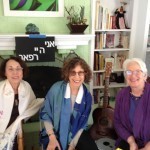Janice Steinberg's Blog, page 3
February 6, 2014
The Wisdom of the Burnout Sisters
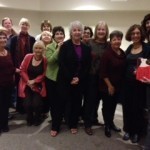 We all know the stereotype of a book club, that it’s a bunch of women who, under the pretense of meeting to discuss books, just socialize and drink. That hasn’t been my experience at all. People in book groups I’ve visited have been insightful readers. And some of their comments have moved and inspired me.
We all know the stereotype of a book club, that it’s a bunch of women who, under the pretense of meeting to discuss books, just socialize and drink. That hasn’t been my experience at all. People in book groups I’ve visited have been insightful readers. And some of their comments have moved and inspired me.
That happened when I met with the Burnout Sisters Book Club last week. The Burnout Sisters really were burned out. Residents of the San Diego suburb of Scripps Ranch, all of them lost their homes in a devastating 2003 fire. (We name our fires in California, and this one was the Cedar Fire.) They bonded initially over their mutual losses, then over a community-wide rebuilding project in which they shared the same builder to keep down costs. Now, 11 years later, they’ve rebuilt and, after living in rental places throughout San Diego County, they’re neighbors again.
In the discussion, one woman said she felt the title “The Tin Horse” was perfect, because she understood the importance of talismanic family objects; she had searched through the ashes of her home for hers, but hadn’t found any. Everyone nodded. They had all been there. Then another woman shared her story, and it felt like a gift:
In the ruins of her home, she found one special object, a ceramic bird her father had made. The bird was old and cracked, and she had kept it wrapped in newspaper. The blaze had refired the ceramic, and carbon from the burned paper had mended the cracks. When she found it, it was whole again.
January 29, 2014
Happy Birthday to The Tin Horse!
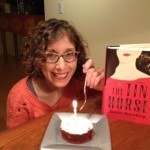 It’s hard to believe, but it’s one year since “The Tin Horse” was published – January 29, 2013! Year 1 has been an amazing ride. A few highlights …
It’s hard to believe, but it’s one year since “The Tin Horse” was published – January 29, 2013! Year 1 has been an amazing ride. A few highlights …
* The launch party at Warwick’s Books in La Jolla was such a high! Walking from the car to the bookstore, I warned myself not to have expectations about how many people would be there … and it was mobbed. I was so moved by all of the friends who came to help me celebrate.
* In February, I spoke at the Breed Street Shul in Boyle Heights, the Los Angeles neighborhood where my novel is set. I was interviewed by Dr. George Sanchez, a USC professor who studies Boyle Heights’ multi-ethnic history. And, true to Boyle Heights’ diverse history, the talk had a wonderfully diverse standing-room-only audience.
 * In August, I spoke to a Hadassah group in Madison, Wisconsin, and my mom was able to attend! (She’s in the yellow shirt in the foreground of the picture.)
* In August, I spoke to a Hadassah group in Madison, Wisconsin, and my mom was able to attend! (She’s in the yellow shirt in the foreground of the picture.)
* On a trip to Paris in November, I found the French version of the book, titled “Les Belles Promesses,” in a bookstore on the Left Bank.
I was touched by how perceptively reviewers engaged with the book. Here’s one of my favorite comments, from The Historical Novel Review: “’The Tin Horse’ offers that rare delight: a sophisticated, character-driven book with a suspenseful, hard-to-put-down plot. … The role of Elaine’s Romanian immigrant mother and the twists in her story will wham you with their humanity and depth. No clichés here.” And “The Tin Horse” was one of O Magazine’s books to pick up in March!
Along with highs, the year has brought some big learning opportunities. I’ve lurched into the world of social media and discovered that not all online material can be dashed off as quickly as a Tweet. Pieces I wrote about my passions for Judaism and dance made me dig deeply to define why these things speak to my soul. And I made a video – you can’t see it, but my hands were pretty much glued to my sides to restrain my tendency to dance with them when I talk.
Click here to view the embedded video.

Burn-out Sisters Book Group
It’s been quite a journey. And it continues. Unlike the old days of book promotion, when you did a flurry of talks at the time a book first came out, many of my events are visits to book groups, where everyone has read the book. That has been a very special pleasure. During the years I was writing the book, “my readers” were a vague presence. Now they are real faces and voices, and I’m honored to hear how ”The Tin Horse” resonated with them.
January 21, 2014
Scenes from an Editing “Marriage”

Kendra Harpster (l) with publicist Michelle Jasmine and assistant Kaela Myers, wearing Tin Horse necklaces
I just came across an online discussion on “The Editing Myth” in which many writers seem to believe that real editing is a thing of the past. That’s what I thought, too, until I worked with Kendra Harpster at Random House. Here’s my WSJ piece about our editing “marriage.”
Wall Street Journal – Jan. 26, 2013
When people talk about the classic age of editing, it brings to mind the kind of intimate connection that existed between Maxwell Perkins and the authors he discovered, among them F. Scott Fitzgerald and Ernest Hemingway. The great editors like Perkins, Robert Gottlieb, and Gordon Lish got their hands dirty with every detail of their authors’ work, and sometimes of the authors’ lives.
Legendary editor-author partnerships had a lot in common with marriage, both as a union of kindred souls and as a battleground. Take the association between Mr. Lish and the late short story writer Raymond Carver. Their on-the-page process is laid unusually bare in “‘Beginners,’ Edited,” which was published in The New Yorker in 2007 and shows the full text of one of Carver’s signature stories as he submitted it to Alfred A. Knopf, and as Mr. Lish edited it.
Initially, the edits are on the word and sentence level. Some seem capricious–a man named “Herb” becomes “Mel”–but you can see Mr. Lish shaping Carver’s spare style as he prunes the back-story and emotional cues: “Laura, my sweet, big Laura, said evenly” is cut to “Laura said.” As the story proceeds, the red pencil slashes. Mr. Lish deletes most of the latter half, including the final 1500 words, and adds the story’s ending.
For an author, the extent of the changes seems excruciating, and apparently Carver found it so. On the other hand, authors dream of having an editor who cares as passionately as Mr. Lish did about every word. And no one would pick Carver’s title for the story, “Beginners,” over Mr. Lish’s: “What We Talk About When We Talk About Love.”
His brand of editing no longer exists–or so I believed when my novel, “The Tin Horse,” sold to Random House in the fall of 2010. The novel tells the story of the search by the elderly Elaine for her vanished twin sister Barbara, and unveils secrets from their youth. Kendra Harpster, who would be my editor, assured me that she would be hands-on, and said she felt our partnership was bashert, a Yiddish word that means predestined. Still, my editing expectations stayed low.
Two months later, I received my first editorial letter from Ms. Harpster. Its 18 single-spaced pages were filled with questions about characters and motivations: “In what other instances did Barbara push Elaine’s cautious nature? Where did that cautious nature lead her?” Ms. Harpster pushed me to refine dialogue and internal monologue around what she perceived as the book’s theme: “the unavoidably subjective ways (we) shape the narratives of our destinies.”
I sometimes fall in love with a phrase as language, even if it fudges the truth. I wasn’t allowed to get away with that. I’d had Elaine, my protagonist, say, “My life of duplicity began in earnest that night.” Harpster asked, “Is this a little hyperbolic?” I ended up changing it to “My season of duplicity.”
In what I think of as classic fashion, she and publisher/editor-in-chief Susan Kamil also gave me a two-year process of letting ideas develop and be refined. The editorial engagement never flagged. On perhaps her fourth time through, Ms. Harpster read the entire book aloud. On that read, she added a comment by Elaine that charmed me, “In those days I was an amateur at irony.”
Even more important was “thinking away from the page” about what might be missing. Ms. Harpster wanted me to expand the present-day story that now takes up about one-quarter of the book. She refrained from being too directive as to how I should do that. She planted the seed, and it led me to bring Elaine’s youngest sister, Harriet, into the present-day story in Chapter 4, rather than Chapter 17; now I could play the two sisters’ family narratives against each other.
And that, perhaps, is where editing skill becomes editing magic, and an author-editor relationship might even be bashert: when an editor is so attuned to an author that she knows when to jump in and when to exercise restraint.
January 14, 2014
My Passion for Judaism
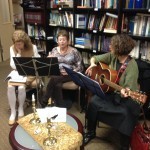 Last weekend, I led two Jewish services, one on Friday night at my synagogue and the second on Saturday morning for my Renewal group. I led prayers – singing and playing guitar and drum – and shared a teaching about the Torah reading, the one where the Israelites are fleeing Egypt, the sea miraculously parts, and, after they cross the sea, they burst into song.
Last weekend, I led two Jewish services, one on Friday night at my synagogue and the second on Saturday morning for my Renewal group. I led prayers – singing and playing guitar and drum – and shared a teaching about the Torah reading, the one where the Israelites are fleeing Egypt, the sea miraculously parts, and, after they cross the sea, they burst into song.
As the Talking Heads put it in “Once in a Lifetime” – and with the same tone of disbelief - how did I get here? How, after a very secular upbringing and literally decades of feeling disconnected from Judaism, did I end up leading prayers?
Although the term tikkun olam – repairing the world – wasn’t yet in vogue, the Judaism I experienced growing up in the 1950s and 60s was tikkun olam Judaism: committed to social justice and leading an ethical life. I was proud that the rabbi of our Reform synagogue in Milwaukee – Dudley Weinberg of Temple Emanu-El B’ne Jeshurun – was prominent in the civil rights movement. A high point of my teens was a post-confirmation class with guest speakers including anti- war protestors, black activists, etc.; it led to a group of us petitioning for Black Studies at our very-white suburban high school. (To be honest, the speaker who made the most indelible impression on my 17-year-old self was a poet who advocated free love!)
I continued trying to repair the world when I went to college. I marched against the Viet Nam War. I wrote for progressive newspapers. I embraced the women’s movement. But when it came to Jewish practice, my parents – like Elaine in The Tin Horse - were of the generation that yearned to be American like their neighbors. We celebrated Hanukkah and Passover, and I did get sent to religious school, where I learned the Genesis and Exodus stories and got a heavy dose of Jewish Heroes, people who’d achieved in science or the arts or – less often but cooler – sports, who could give us some muscle-flexing Jewish pride.
But I didn’t have a Bat Mitzvah, nor did either of my brothers have Bar Mitzvahs. Jewish rituals weren’t a significant part of my childhood. And, in my twenties and thirties, the same tikkun olam principles that drew me toward feminism pushed me away from the patriarchal Jewish narrative and traditions. Plus, my husband is a lapsed Catholic, and we don’t have kids, so we had no concern about providing a religious-ethical education. Once every few years, I’d feel a vague tug and try a synagogue … but there was always something that reminded me of why I felt alienated.
What rekindled a sense of connection was a Bat Mitzvah … on my husband’s side of the family. Right, that’s my lapsed-Catholic husband, Jack Cassidy. Jack’s sister also has a Jewish spouse, and in the early 90s, their daughter Rachel had a Bat Mitzvah. Their synagogue in Seattle, Eitz Or, had one of the first women rabbis, Vicki Hollander, and there was a moment during the Bat Mitzvah when the four people standing on the bimah (podium) were Rabbi Vicki, Rachel, and Rachel’s grandmother and aunt on her dad’s side. All women! For the first time in years, I was in a synagogue … and I felt at home.
Shortly after that, I started to plan a new novel in my mystery series. My brother David lives in Tel Aviv (he teaches statistics at Tel Aviv University), and I decided to give my sleuth, a San Diego radio reporter, a mystery to solve in Israel. I could visit David and write it off! Figuring out where in Israel to set the story, I had the thought, “Isn’t some branch of Judaism associated with the town of Safed? And it’s in the Galilee, it looks pretty.” I had no idea that Safed was a centuries-old center for Kabbalah, Jewish mysticism. I wasn’t even aware that Judaism had mystics. (This was before Madonna and other celebrities became devotees of the Kabbalah Center.) But, as research for the book (“Death in a City of Mystics”), I started to read and study. And I was captivated.
Two books spoke to me deeply: Rabbi Lawrence Kushner’s “God was in this Place & I, i did not know” and Judith Plaskow’s “Standing Again at Sinai.” Kushner’s book is a multi-faceted take on Jacob’s dream of a ladder with angels going up and down, and it made me aware that Jewish texts are rich with psychological resonance and open to a multiplicity of interpretations. Reading “Standing Again at Sinai,” a classic of Jewish feminism, I found that during the years when I’d stayed away, there were women who so valued their connection to Judaism that they were insisting on carving out a larger place for us. (It’s a struggle that continues – do you know about the amazing Women of the Wall in Jerusalem?)
I learned about Kabbalah from a great set of tapes (now on CD) by Rabbi David A. Cooper, to which I listened in the car. I was driving through the hills east of La Jolla when I heard the teaching that every blade of grass has an angel whispering to it, “Grow! Grow!” Now, any time I’m on that stretch of I-5, I still hear it: “Grow!” Not that I really believe that. But neither do I disbelieve it. I think what touched me was that the religion I’d experienced as dry and intellectual also had room for this poetic flight of imagination.
Jack and I went synagogue-shopping and found a Reconstructionist congregation, Dor Hadash, and also a Jewish Renewal group, Shir Ha Yam. I’ve linked to sites that explain Reconstructionism and Renewal far better than I could. But briefly, both are progressive, with women in leadership roles. At Dor Hadash, I’ve enjoyed being part of a welcoming, intellectually stimulating community, jamming with a wonderful music group … and getting the opportunity to have my Bat Mitzvah when I was 49! In Renewal, I love the Jubu (Jewish-Buddhist) practices of chanting and meditation and. And, at Renewal retreats, I’ve explored creative ways to dive into texts – I’ve done bibliodrama with Peter Pitzele and Arthur Strimling, and practiced Storahtelling with Caryn Aviv.
In both communities, I’ve discovered that Jewish music speaks to my heart, especially music by contemporary women composers: Rabbi Shefa Gold’s chants, Cantor Linda Hirschhorn’s multi-part a capella songs, Debbie Friedman’s soulful tunes. And – back to, how did I get here? – I’ve found that my love for music, plus the ability to carry a tune and play guitar a little, has led to my being a lay service leader.
I have also become a trop geek. Trop are the melodies used to chant sacred texts, and there are different trops depending on the text. For my Bat Mitzvah, I learned Torah and Haftarah trop. I’ve since acquired a bit of Song of Songs (the melody does sound like a love song). Using the Torah trop for the High Holy Days, I’ve learned to chant the Akeda, the story of the binding and near-sacrifice of Abraham’s son, Isaac, and I’ve grappled with that wrenching story … and that gets me into the new novel I’m writing, in which one character is studying to be a cantor and will chant the Akeda for the first time.
December 26, 2013
7 Rules to Write By – Links to All 7!
 For everyone who’s making a New Year’s resolution to finally start – or finish – that novel … here, in one place, are all 7 of my rules to write by, with links to the blog for each one. I’m using a pic from when I found the French edition of “The Tin Horse in a bookstore on the Left Bank, because it was such a thrill. The French publisher decided to call it “Les Belles Promesses” – the beautiful promises.
For everyone who’s making a New Year’s resolution to finally start – or finish – that novel … here, in one place, are all 7 of my rules to write by, with links to the blog for each one. I’m using a pic from when I found the French edition of “The Tin Horse in a bookstore on the Left Bank, because it was such a thrill. The French publisher decided to call it “Les Belles Promesses” – the beautiful promises.
Here are my rules. Wishing you happy, brilliant, satisfying writing – with love and support from everyone in your life – in 2014.
3. Find the right critique group for you. Plus 3a on how to critique.
4. Have the will and skill to revise.
6. Choose your agent carefully.
November 6, 2013
Thou Shalt Afflict Thy Protagonist
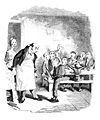
George Cruikshank engraving
It happened again yesterday. A friend in my writers group kept taking her protagonist into situations that made everyone squirm … but then backed off. For instance … The character is an immigrant maid, and the house in which she works gets sold. She meets the new owner, including his flirtatious twenty-something son. The maid is staying in the house alone just before the new owners move in, and the son shows up in the middle of the night. She throws a shawl over her nightgown and lets him in. He pours himself a glass of brandy and offers one to her. Why not? she thinks. Uh-oh, we know what’s coming. But it doesn’t! She drinks her brandy, returns to her room, locks the door, and spends a peaceful night, her virtue unassailed.
Granted, the young aristo putting a mash on the maid is a cliché, and that, my friend said, was why she didn’t want to go there. But just about everything and everyone in the protagonist’s life is nice. That’s a problem, and not just because “niceness” is antithetical to drama. A character grows through facing adversity. That means you have to put your beloved protagonist through the wringer.
As screenwriting guru Robert McKee says in Story, “True character is revealed in the choices a human being makes under pressure – the greater the pressure, the deeper the revelation, the truer the choice to the character’s essential nature.”
The characters we love must be unfairly accused, cheated in love and in business, press-ganged, betrayed, tricked, thrown into excruciating social situations, saddled with unbearable family members, threatened, laughed at, imperiled, spurned, one-upped, opposed, dragged through the mud, humiliated, misunderstood, pummeled, starved. (Depending on the kind of book you’re writing, this suffering may be literal, or it may be purely psychological). We need to subject our protagonists to experience loneliness, anxiety, misery, loss.
If your gentle writerly self balks at being so cruel, consider: what if, when Oliver Twist asked, “Please, sir, I want some more,” a kindly soul had smiled and filled his bowl? A happier life for young Oliver. For the rest of us, deprivation.
October 29, 2013
Stories Everywhere: Crying Men & A Seal Birth
 “We are narrative beings,” said Margaret Atwood, an author I revere, at the Los Angeles Times Book Festival last spring. Along with food, shelter, and sex, one of our most basic needs is to hear and create story. Fortunately, stories are everywhere. Two stories got their hooks into me last week, one where I had to fill in the pieces and another already fashioned into a magical narrative.
“We are narrative beings,” said Margaret Atwood, an author I revere, at the Los Angeles Times Book Festival last spring. Along with food, shelter, and sex, one of our most basic needs is to hear and create story. Fortunately, stories are everywhere. Two stories got their hooks into me last week, one where I had to fill in the pieces and another already fashioned into a magical narrative.
The story with missing pieces is about the crying men. Dropping off a friend at her condo, I saw a man sitting on the low brick wall outside, hugging his knees to his chest and all-out bawling, his sobs audible through the closed car window. The man was youngish, in his twenties or thirties, and a bit rough-looking, his fair skin sun-weathered as if he lived on the street. Possibly homeless, possibly mentally ill. And most likely harmless, though I took normal urban precautions and drove a little up the street to let my friend off.
The next day, I heard wailing and moaning coming from outside my condo building. I looked out and saw a man lying on the ground right under my second-story window. He didn’t move, he just lay on his back and moaned, his legs bent at an angle that I associate with chalk drawings of corpses in police dramas. Was he ill? Should I go out and talk to him? But part of the crying men story is my sense of vulnerability as a small woman. I thought of calling the police, but worried that the last thing this guy needed was to get picked up by cops. Fortunately, my husband was home. He went out, talked to the man, and gave him a hand to help him up. The man slurred and mumbled as if on drugs, but he was well enough to stand and walk down the street.
In our relentlessly upbeat culture, it’s rare to witness such public pain. I keep thinking about the men, hoping their lives will get better. Then there’s my storytelling impulse, which, like other fundamental drives, is not about compassion but about a hunger, in this case for meaning. The storyteller in me sees the appearance of two weeping men in two days in mythic terms, perhaps as a sign of a wounded masculine in a time of massive shifts in what it means to be male and female. Or maybe the story has to do with the wounds all of us carry coming to the surface. A psychic friend says we’re transitioning into the Age of Aquarius, and it will ultimately be great, but it’s going to be rocky getting there.
 The other story that came my way was about mythic creatures – elephant seals, massive animals that can weigh as much as 500 pounds. A friend and I discovered in conversation that we had both visited the seal rookery at Piedras Blancas, on the central coast of California between Cambria and San Simeon (the site of Hearst’s Castle). She happened to be there one day when all of the female seals formed a circle around another female. There was a gush of blood from the encircled female, and then she gave birth. The community of females stayed in their protective circle until the birth was complete. Afterward, the gulls performed their task in the ecosystem and ate the blood and afterbirth.
The other story that came my way was about mythic creatures – elephant seals, massive animals that can weigh as much as 500 pounds. A friend and I discovered in conversation that we had both visited the seal rookery at Piedras Blancas, on the central coast of California between Cambria and San Simeon (the site of Hearst’s Castle). She happened to be there one day when all of the female seals formed a circle around another female. There was a gush of blood from the encircled female, and then she gave birth. The community of females stayed in their protective circle until the birth was complete. Afterward, the gulls performed their task in the ecosystem and ate the blood and afterbirth.
I heard about the elephant seal birth in between seeing the first and second crying man, as if the author of the life-book I was reading last week wanted me to connect them. Thinking of the two stories as related chapters, it strikes me that the seals instinctively know what to do when a member of their community is weak and in need of protection. In our human community, it’s more complicated.
What stories are appearing in your life? How do you use narrative to make meaning?
September 17, 2013
A Sexagenarian Rant
As a San Diegan, I’ve heard ad nauseum about our headlocking former mayor, Bob Filner. So I’ve seen multiple references to one of the recipients of Filner’s amorous advances, widely described as a 67-year-old great-grandmother … with the implication that no one in his right mind would be attracted to a woman this old. (One of these links is so funny, I’ve got to share it in its entirety: “67-year-old-great-grandmother-on-san-diego-mayor-bob-filner-he-hugged-me-and-kissed-me-i-was-appalled-i-was-shocked”)
I’m no doubt a tad sensitive about this in my own sexagenarian years, but this was just the first of several infuriating references to people in their sixties and above, in which people seem amazed that we do meaningful work, pack political clout, and yes, are sexual beings.
Just when I was stewing about the great-grandmother in San Diego, I visited my home state of Wisconsin and heard about the grandmas arrested for participating in Solidarity Sings at the state capitol in Madison (these protests have happened daily since Gov. Scott Walker signed his union-busting legislation – on, Wisconsin!). Granted, the Madison grandmothers consciously play with the age issue, calling themselves the Raging Grannies. But again, there’s that assumption that older women are harmless, toothless, something of a joke.
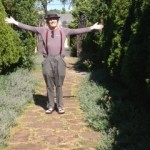
My suspender guy, Jack Cassidy, in Oshkosh, WI
Women get the brunt of this, but there are also cute, harmless codgers like Lawrence J. Zottarelli. Zottarelli, 77, is a NASA engineer who was brought out of retirement because of his unique ability to write the streamlined code needed by the Voyager I spacecraft. Voyager I, launched in 1977, has left our solar system, and, as the project manager said in a quote to the New York Times, “These younger engineers can write a lot of sloppy code, and it doesn’t matter, but here, with very limited capacity, you have to be extremely precise and have a real strategy.” The Times article, which I read on my iPhone while I was waiting for an application of hair coloring to sink in, mentioned Zottarelli’s “striped suspenders and graying hair.” Gray-haired guys who wear suspenders are adorable; I know because I’m married to one. The suspenders didn’t make it into the print article (and now it’s no longer in the online piece, either), but both versions also gave us the project director, Edward C. Stone, another 77-year-old, looking at a computer screen through his trifocals. Makes you want to pinch his cute, wrinkled little cheek.
Maybe because of the hair coloring – plus, it doesn’t hurt that I teach dance-fitness classes – I haven’t yet been personally seen as doddering. But at a talk I gave about my novel, The Tin Horse, I was asked why I made protagonist, Elaine, 85. The book’s inciting incident is a discovery Elaine makes when going through old papers; having made that discovery, she takes a number of actions, and shouldn’t she have been, say, in her 60s? I pointed out that Elaine had a career as an attorney, and in her 60s she was still working; when would she have had time to sort through papers? She was way too busy doing stuff – like me at 63, promoting The Tin Horse, writing a new novel, and, um, having sex with my gray-haired guy in suspenders.
September 11, 2013
“No one has to walk backwards without applause”
 Today, September 11, would have been the birthday of Lynn Luria Sukenick, the teacher/mentor/friend/matchmaker (really, she told Jack and me to meet each other) who saw in me things I hadn’t yet imagined. Lynn, a beautiful writer and luminous presence, passed away in 1995. Her book Houdini is turned out on one of the shelves above my desk. Here’s one of my favorite poems from Houdini.
Today, September 11, would have been the birthday of Lynn Luria Sukenick, the teacher/mentor/friend/matchmaker (really, she told Jack and me to meet each other) who saw in me things I hadn’t yet imagined. Lynn, a beautiful writer and luminous presence, passed away in 1995. Her book Houdini is turned out on one of the shelves above my desk. Here’s one of my favorite poems from Houdini.
Sometimes it takes
a pedagogical turn;
No one has to be wrapped up
in his own habits forever;
no one has to endure
a dead marriage or a leaden body;
no one can fail to respect
a hard-working woman
however heavy her former debt;
no one has to walk backwards
without applause;
no man can evade himself
without confronting his bonds.
August 20, 2013
7 Rules to Write By – #7. Choose an editor who shares your vision
We all know what happens when a novel is sent out to publishers. There’s one rejection, and then another, so many that the author can paper a wall with them. And then finally, when the despairing author is ready to put a gun to her head, one special editor sees how sparkling and wonderful the book is, and says yes.
The rejected author trope is as embedded in our psyches as the sweet young thing tied to a railroad track with Dudley Do-Right racing to save her.
Click here to view the embedded video.
Every author knows how to do rejection and misery. But what if it doesn’t unfold that way? I never thought I’d be courted by publishers. And I had absolutely no road map for what to do. But it happened. And I hope it will happen for you. Here are some things I learned.
Money isn’t everything. Okay, money’s a lot, especially if you have a history of doing freelance work where, if you figured out how much you were making per hour, you’d weep. But when I got the final offers in an auction, all of them were enough to impress my mother that I was actually capable of earning money as a writer. Other things were more important in deciding which publisher to sign with.
If multiple editors are interested in your book, it turns out you get to talk to them. The day before The Tin Horse was auctioned, I got to have 30- to 60-minute phone conversations with each editor who was planning to bid. These talks were, first of all, Nirvana, all of them starting with a big New York editor saying how much she (they were all women) loved the book.
This made me so jubilant and floaty it was hard to focus, but after the making nice came the important part of the conversation: hearing what the editor felt I should revise. This, of course, was my audition, in which I needed to demonstrate my lack of prima donna-ism. But it was also my chance to audition the editor and consider:
1) whether her suggestions resonated – could I envision making the kinds of changes she had in mind? Interestingly, although there were obviously no details at this point, each editor did outline some general areas that gave me a feel for this.
2) how it felt, emotionally, to talk to her – was she someone I felt I’d enjoy working with, and with whom I’d be in good hands?
3) whether I felt she shared my vision for the book
About that elusive, crucial vision. I – and I think most writers – start a book with a radiant idea of what the book could be. Then I begin to mold words into sentences and scenes, and run up against problems of craft, limitations of skill, the teeth-gnashing frustration of knowing how I want my characters to end up but being unable to get them there in a way that feels organic rather than contrived. So there’s a gap, and it can be vast, between that original glowing promise and what ends up on the page. What I tried to sense, in those brief phone meetings with editors, was whether an editor glimpsed the beautiful, true book I’d dreamed of writing and could help me narrow the gap.

Kendra Harpster (l) with publicist Michelle Jasmine and assistant Kaela Myers, wearing Tin Horse necklaces
The editor from Random House, Kendra Harpster, opened our talk by saying she felt it was “bashert” for us to work together. Bashert is a Yiddish word often translated as “soulmate.” To me, it implies a spiritual connection between two people which is so strong that wherever they start out in the world, they’re compelled to find each other. With Kendra, more than any other editor, I felt she got my vision. That’s why I went with Random House.
And it mattered. I’d had the idea that editors don’t really edit anymore, they just acquire books. All of the editors to whom I spoke made a point of saying that they did hands-on editing, but people make all kinds of promises when they’re courting. To my amazement, it turned out to be true. Starting with an 18-page single-spaced editorial letter, Kendra spent two years working with me to bring the book I’d written closer to the book I’d hoped it could be.
So, if the gods smile on you and you’re able to choose your editor, look for a soulmate.
This is the last of my “7 Rules to Write By.” Here are all seven with links to the blog for each one:
3. Find the right critique group for you. Plus 3a on how to critique.
4. Have the will and skill to revise.
6. Choose your agent carefully.
7. Choose an editor who shares your vision.

